 |
| Starlight traveling to P&CW Farm. |
"Starlight, star bright, first goat I see tonight, I wish I may, I wish I might, have this wish I wish tonight. Starlight, I wish to have another sweet Saanen/Alpine cross dairy doe on our farm. Will you come home with me?"
"You betcha, lady." Now, how's that for an agreeable goat?
Starlight moved to our farm from Bethpage, Tennessee a week or so ago. A Saanen/Alpine cross like our undisputed dairy queen, Marcie, Starlight has the sweet temperament associated with the breed. She is said to have consistently produced about three-quarters of a gallon daily on the kid-share plan (where she is milked for human consumption in the morning, then allowed to keep her kids at her side throughout the day before being separated from them again overnight) earlier this year.
Although considerably smaller than our Marciegoat, who is known for throwing her weight around to get what she wants, Starlight is just as personable. She knows and responds to her name and enjoys the company of people. (While our Nubian does will gravitate toward any human bearing food, they prefer to stay just out of reach--not seeking the hands-on attention our other goats seem to like.) At first, when I was outside I served as her herd, and she orbited around my movements with care. Now, I am glad to report, she gravitates toward other goats while still keeping loose tabs on me.
On arrival, Starlight was considerably underweight. (On a body-score scale of five, with 3 being ideal, I'd say she was a 2. Not emaciated, but pretty bony. By contrast, Marcie manages to maintain a 4 as her norm.) We've kept this new goat kenneled with the guardian Biscuit for company at night, and allowed her to roam and browse--still separated from the other goats by fencing--during some daytime hours.
At first the stress of moving caused her some upset. After about two days, though, her digestive tract stabilized and she returned to trailing little goat pellets behind her. Thereafter, I began trimming her feet, nipping off the longest parts while she grazes; I'll finish the job once she's up top with the other goats and we can put her on the milking stand. Tonight, I'll give her some pelleted goat wormer to assist her with weight gain. And soon I'll turn her out up top where she can browse with the other does and with those rapidly-growing Savannah-cross doelings, Taylor and Shea.







